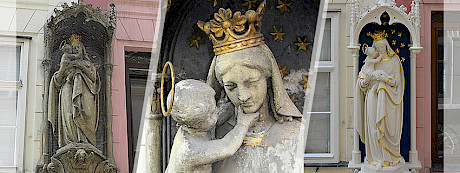Ethyl-silicate Consolidation for Porous Limestone Coated with Oil Paint – A Comparison of Application Methods
06/09/2016 - 10/09/2016By M. Milchin, J. Weber, G. Krist, E. Ghaffari and S. Karacsonyi
Abstract
Ethylsilicates (TEOS) are frequently used to consolidate porous limestones usually by full immersion in a consolidation bath or by run-off application in situ. For porous limestones with their high level of capillarity these methods are sufficient to achieve reasonable results as long as the surface is uncoated. However, when covered with oil-based paints or similar coatings stone surfaces effectively become impervious, which prevents consolidants from penetrating into the material, so alternative ways of application are required. This paper describes the case of a 19th century sculpture from Vienna, Austria. It was carved out of a porous calcareous arenite and originally painted with oil colour; over time several secondary layers of paint have been added. Some areas of the stone sculpture were in a very bad condition; the goal of the treatment was to consolidate the stone, but to preserve the original polychrome paint layer. Tests were conducted on dummies to achieve optimum penetration of the consolidant through the surface layers by three approaches, namely (1) total immersion, (2) run-off application, and (3) a patented low-pressure impregnation treatment known as VCP (Vacuum-Circling-Process) (Pummer 2007). The test specimens were coated with an oil-based paint prior to their laboratory treatment with TEOS in the mentioned ways. Penetration depth and drilling resistance were assessed and samples for polished thin sections were taken, on which polarizing light and scanning electron microscopy was performed. This latter group of analyses provided significant results in respect to the deposition of the silicate gel after consolidation. Based on the results, the sculpture itself was treated with the VCP-method and the effect was verified. It can be concluded that the VCP application is suitable for the consolidation of stone objects with a surface of inhomogeneous or reduced permeability.
1. Introduction
For several decades ethylsilicates (TEOS), primarily developed and marketed to strengthen siliceous sandstones, have likewise been used for the consolidation of porous carbonate materials such as soft limestones from the Tertiary Leithakalk formation. These lithotypes play a predominant role for sculptural and architectural stonework in eastern Austria (see e.g. A. Kieslinger 1951, A. Török et al 2004, and A. Rohatsch 2005). TEOS is known to stabilize decohesive grain textures in these limestones and is thus widely used by conservators. However, its efficacy is frequently questioned by materials scientists (see e.g. C.A. Price&E. Doehne 2011 and G. Wheeler 2008); the chemical diversity between carbonate substrate and silicate consolidant is sometimes interpreted as a “chemical incompatibility” between both systems. This fact seems to account for the frequent observation by SEM that silica gel from TEOS treatments of limestones or mortars though precipitated in pores and cracks, show a rather poor contact with the calcitic mineral grains. Based on SEM observations alone, some scientists tend to doubt the ability of TEOS to consolidate limestones in general, notwithstanding the proven physico-mechanical effects of such treatments. Efforts have been made in the recent past to produce modified TEOS specialised for the consolidation of limestones. These specialised products were not part of the present study but have shown some problems on their own and should certainly be looked at more closely in future.
Some of the earlier applications of TEOS on façades in Vienna have caused problems in recent years. Strong delamination parallel to the surface can be observed. However, in most cases such failure is linked to either wrong application methods (e.g. spray or brush), or the application of TEOS on wet stones, or even the use of water (!) as a diluting agent.
In general the use of TEOS for the consolidation of porous Leithakalk limestones proved a good practice as long as the surfaces are permeable and the consolidant is not restricted from entering the structure. A critical situation emerges when porous limestone objects have their surfaces sealed such as when stones are covered with paint layers or coatings. In such situations the substrate is often very porous and in need of a consolidation, the coated surface however prevents the consolidant from penetrating. If the layer sealing the surface is of no historic or artistic value, its removal can be a possible solution, although the risk to damage the stone underneath may necessitate a number of additional measures on beforehand. In case the layer shall be kept e.g. because it represents an original paint, the problem becomes more difficult to handle. This is the case with the object presented in this paper, where a sculpture made out of a highly porous limestone, coated with layers of paint, most of which are oil bound was in great need of a structural consolidation.
2. The sculpture
The object of concern is a life-sized sculpture depicting the Madonna with Child (Fig. 1), carved out of a highly porous calcareous arenite. It is carved from Au Stone - named after the locality of extraction in the Southeast of Vienna – which is one of the softest lithotypes of the Tertiary Leithakalk formation. Formed in coastal areas of the shallow shelves of the Miocene Paratethys, this stone type was extracted from numerous quarries located in Eastern Austria, Southern Moravia and Western Hungary (Török et al. 2004). Rohatsch (2005) describes Au Stone as detrital limestone composed of fossil fragments (mainly Corallinaceae) and foraminifera at a grain size of below 2 mm. Feebly cemented by sparitic calcite, the average total porosity of the sound stone is well above 30 % by volume, and its water uptake amounts to about 17 % by mass. From the 14th to the late 19th century, Au Stone was probably the most appreciated Leithakalk variety for sculptural stonework in Vienna and surroundings. The sculpture is dated to the middle of the 19th century, and was produced by the Viennese sculptor Joseph Käßman (1784-1856). It was originally painted with a linseed oil based paint containing lead white as pigment, accented with some gilded sections (crown and details of the dress). The sculpture was placed on a façade in the seventh district of Vienna where it remained on site until it was first moved for conservation in 2012; earlier interventions consisted in frequent repainting, according to the fashion of the time. While most of these secondary layers are also oil bound, the most recent ones are based on acrylic emulsion as binding medium.
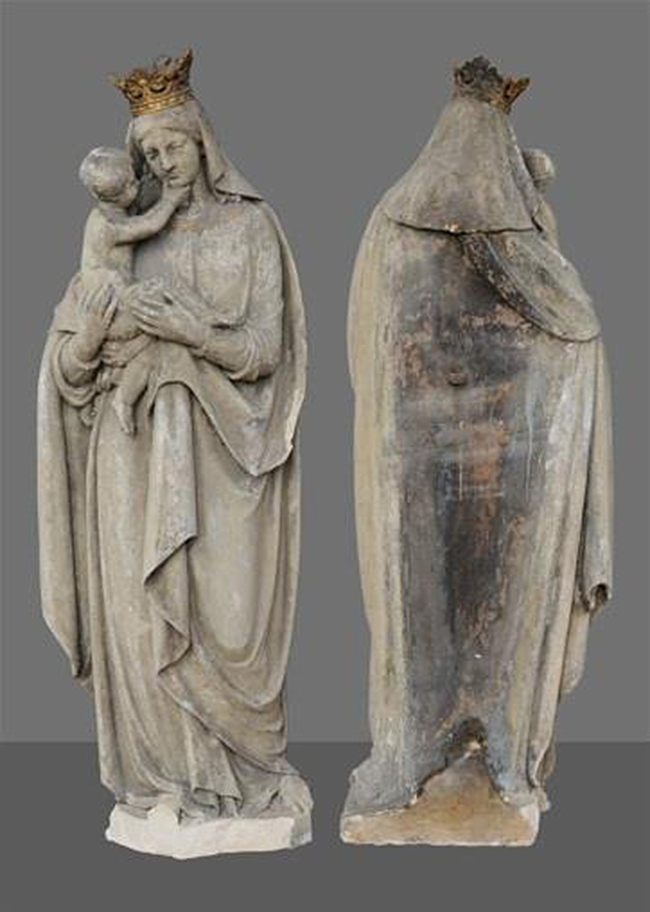
Fig. 1: The sculpture of a Madonna with Child, 19th Cent., Vienna, by Joseph Käßman
During the recent campaign, the sculpture had to be removed from the façade because of its instability and the danger of losing pieces. When delivered to the atelier, the most exposed parts such as sections from the drapery and the feet were already heavily cracked or broken in many pieces. Initial analyses by light microscopy confirmed the presence of an original paint layer. Drilling resistance showed the poor condition of the stone underneath. It was therefore decided that the sculpture had to be consolidated. Based on the drilling resistance profiles, it was obvious that a deep penetration was essential. To this end, the consolidant had to penetrate through the craquele in the oil paint layer, or find its way through the few lacunae.
3. Methods
In view of the above, it was decided to perform a small laboratory program in order to test different application methods of TEOS consolidant on test specimens that were prepared in a way to imitate the presence of an impervious layer with just a few defects. Cubes of approx. 40×40×40 cm were cut out of a block of a Leithakalk limestone similar, though not identical to the original stone, since that exact type is no longer available. The cubes were coated with a commercial white oil paint. An area of 10×10 cm was left uncoated, simulating the usually unpainted underside. A split line was prepared on 4 sides before the paint layer was applied in order to facilitate the splitting of the cubes after consolidation. After the curing of the paint layer, different types of defects were produced in order to simulate those found on the object. Three drilling resistance profiles before consolidation were measured for all of the cubes on three different faces.
The blocks were then consolidated using different application methods. The test of the runoff method consisted of applying consolidant by means of a wash bottle in a way that it was left to freely flow over the surfaces until no more liquid was absorbed. In addition, the impregnation by total immersion in a bath was tested. With this test, the specimen was placed in the solution in such a way that first the consolidant was absorbed by capillarity before it was fully immersed until no more air bubbles were released. The final method was a patented method known as VCP or Vacuum-Circling-Process (Pummer 2007) and was employed by the patent holder. This procedure, frequently used in situ, is based on the airtight packing of the stone element, which is then subject to a regime of under-pressure to which the consolidant is injected. More details are given elsewhere in this volume (Pummer 2016). The TEOS product used in all three cases was Funcosil-300E® by Remmers, Germany, a concentrated elastified ethyl silicate with a gel precipitation rate of 300 g/L. For the VCP treatment this consolidant is modified to facilitate the process of hydrolysis.
Immediately after the application of the consolidant, the cubes were separated along a predetermined split line. The penetration depth was measured and photographically documented. Afterwards the fragments were reassembled to cubes using force loops and a tape, in order to re-establish as far as possible the initial conditions. After a period of 6 weeks, a time span commonly considered sufficient for the hydrolysis of TEOS, the drilling resistance was again measured and compared to the initial readings. Additionally small drill cores were taken for polished petrographic thin sections, which were produced after vacuum impregnation with a blue-dyed epoxy resin. These sections were analysed in a polarizing light microscope as well as by SEM under low vacuum. Based on the SEM-BSE images obtained in which the precipitated TEOS silica gel is revealed by a specific grey, its distribution in depth as well as its precise topographic position in the pore structure was visualized in pseudo colour. This not only allows for easier apprehension of the distribution of the consolidant in the micrographs, but would also enable digital image calculation of relevant parameters such as the degree of pore filling in selected areas of a depth profile, a procedure not followed however in frame of the present study.
In general, the information gained from the micrographs in combination with the readings from the drilling resistance and the penetration depth measured on the split planes all contributed to the final decision regarding the treatment of the sculpture.
4. Results
4.1. Test Series on Dummies
The first test results were based on the observation of the penetration depth along the split faces. The cubes that had been treated in a consolidation bath and by the VCP method, respectively, appeared fully soaked with the consolidant. On the contrary, the cube treated in the run-off test showed very low penetration depths of 0-7 cm (Fig. 2). In particular, the penetration was dependant on the condition of the paint layer in a specific area. Where the colour was scratched or lacunae were present, the consolidant could penetrate the stone fairly well. In areas with intact paint-layer the penetration depth was either very small or not determinable.
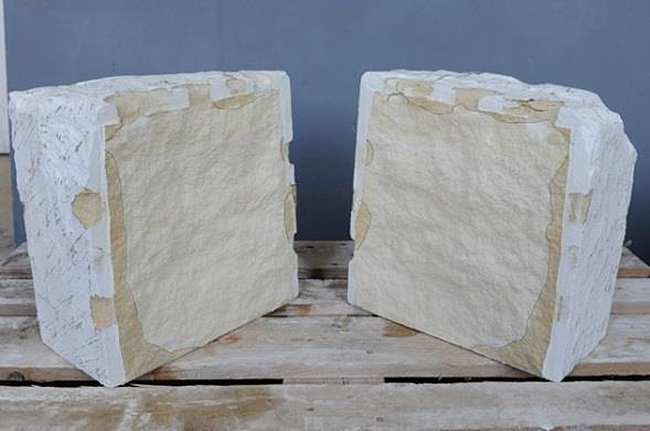
Fig. 2: Low and irregular penetration depth by run-off
The measurement of drilling resistance proved to be of limited use in the case of the dummies. This is probably due to the lack of strength profiles in the unweathered specimens before treatment. The cubes that were consolidated by total immersion and the VCP method had a uniform increase of the resistance after the treatment, while the cubes treated by the run-off method showed no relevant strength increase. On the contrary, drilling measurements yielded highly significant results for the sculpture with its obvious weathering profile (see 4.2).
Observations by optical microscopy and SEM revealed not only differences in the penetration depth of the consolidants for different modes of treatment (Fig. 3), but also showed that the specific places in the pore system where the silica gel preferentially precipitated or accumulated were likely governed by the method. As expected, virtually no silica gel could be detected in the sample from the cube that was treated by the run-off method, whilst the samples treated both by total immersion and by the VCP-method revealed significant amounts of silica gel in the full length of the drill core. In either case, however, the amounts of precipitate decreases with depth. In respect to the preferential position of gel precipitation, the consolidant was able to penetrate in smaller pores and thinner cracks when applied by the VCP method than in the case of total immersion, though the differences seem to be slight and further tests with more samples must be performed to clarify whether these observations are of relevance. Another observation relates to the deposition of the gel on the surface. While no silica could be detected on the surfaces of the sample consolidated by the VCP-method, the full immersion test left behind a surface coat of gel even though the surface of the cube had been dried with a tissue after removal from the bath. It is likely that this layer had formed in the course of backwards migration of the consolidant during evaporation, a process that would have not taken place in the VCP test, either because the gel was preferentially trapped in smaller pores, or because of the reaction-facilitating additive.
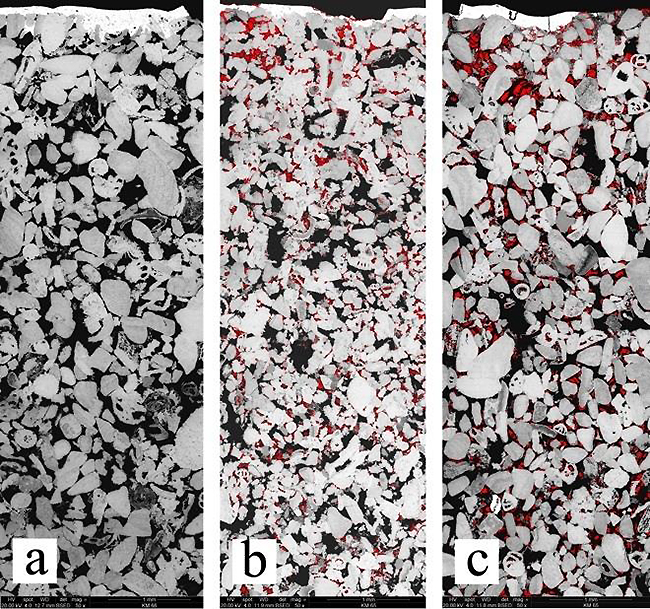
Fig. 3: In-depth distribution of silica gel (in pseudo colour) in the dummy stone subject to laboratory treatments (a) run-off, (b) mmersion, and (c) VCP. SEM-BSE of polished thin sections, surface on top, depth of scanned area ca. 8 mm
4.2. Consolidation of the Sculpture
Following the results from the laboratory test series, the decision was made to consolidate the sculpture using the VCP method, which was performed by the company that holds the patent. After the curing period, drilling resistance measurements were conducted in six areas of the sculpture that had shown different degrees of decay, and were compared to drillings that had been made in the same areas before consolidation. Fig. 4 graphs this comparison and shows a significant increase in strength post-consolidation, with the greatest effect in the outermost 3 or 4 centimetres that had been in an extreme state of poor cohesion.
Just one core of 2 cm in diameter could be drilled out of the sculpture at its back side to check the consolidants precipitation in a polished thin section by polarizing light microscopy and SEM. Figures 5a and b illustrate the position of the gel at a depth of 2 cm from the surface. The findings support the drill resistance profile in that the VCP treatment of the sculpture has produced good results of consolidation.
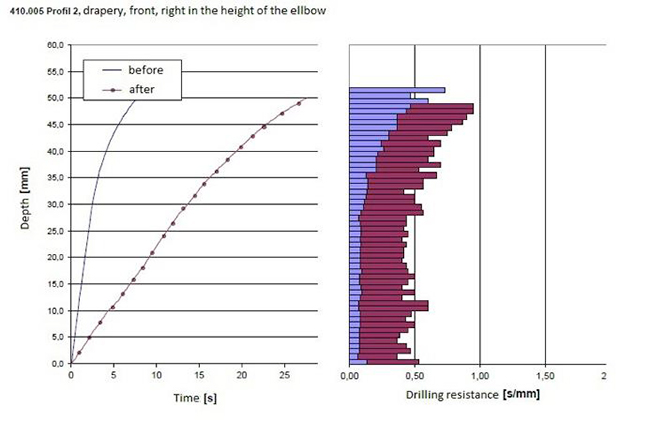
Fig. 4: Drilling resistance, before and after treatment, sculpture Madonna with Child. The graph shows an example representative of a total of six measurements taken in different places of the sculpture
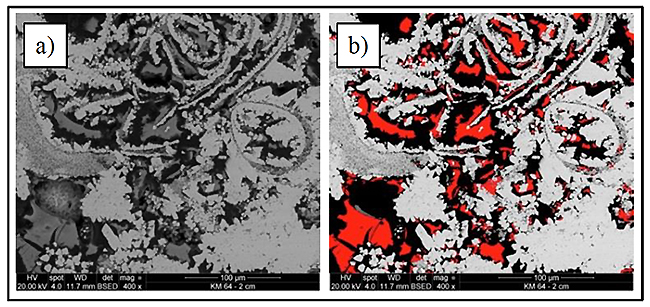
Fig. 5: In-depth distribution of silica gel (in pseudo colour) in the dummy stone subject to laboratory treatments (a) run-off, (b) immersion, and (c) VCP. SEM-BSE of polished thin sections, surface on top, depth of scanned area ca. 8 mm
The amount of gel gradually decreases with the increase in depth. This finding, supported by the steady graph of the drilling resistance, correlates with the decreasing need for consolidant in the depth where the stone is in better condition. While quantitative values typically are not producible to establish the efficacy of a consolidation treatment along a gradient, one can try to estimate trends achieved by a treatment. The effect shown in our case was that the pronounced strength gradient before the consolidation has been partly flattened out, showing that the strength of the subsurface zone of the stone was significantly increased.
5. Conclusions
The results from the laboratory test series as well as from the treatment of the sculpture itself point to the fact that the consolidation with TEOS using the VCP-method is a very good possibility to consolidate porous limestone objects coated with layers of low permeability. The VCP-method offers one possibility to master these problems. In the present case, the surface of the sculpture was covered with oil paint, but the results seem to be relevant to similar stones with different kinds of surface sealing coatings. The total immersion in a consolidant bath also proved to be a useful method when executed properly. The limitation of the size of the object is more relevant to the total immersion treatment than to the VCP-method. In recent years rather large objects have been treated with this method. Another advantage of VCP is that it can be done on site without dismantling any structures, as opposed to the full immersion technique that must be done in a studio, which can be difficult if not impossible for large structures.
Acknowledgements
Thanks are due to G. Fleischer from the Austrian Research Institute (ÖFI) for the measurements and data processing of drilling resistance on the sculpture as well as on the test cubes. Thanks go also to A. Baragona for editing the language of the text.
References
Kieslinger, A., 1951, Gesteinskunde für Hochbau und Plastik, Österreichischer Gewerbeverlag, Vienna, Austria.
Price, C. A., and Doehne, E. 2011. Stone conservation: an overview of current research. Getty Publications.
Pummer, E., 2007, Steinkonservierung; Die Kremser Dreifaltigkeitssäule, Selfpublished, Rossatz, Austria.
Pummer, E. 2007. European Patent no. 1295859 Vacuum Circular Consolidation Method. Owner Erich Pummer GmbH.
Pummer, E., 2016, Vacuum-Circling Process: Innovative Stone Conservation Method. In: Proc. 13th International Congress on the Deterioration and Conservation of Stone, Glasgow, 6-10 September 2016 (this Volume)
Rohatsch, A., 2005, Neogene Bau- und Dekorgesteine Niederösterreichs und des Burgenlandes, In: Mitt. IAG BOKU, Institut für Angewandte Geologie, Universität für Bodenkultur Wien, Nutzbare Gesteine von Niederösterreich und Burgenland - „Junge Kalke, Sandsteine und Konglomerate – Neogen, Vienna, Austria.
Siedel, H.,Wichert, J. and Frühwirt, T., 2016, Application of ethyl silicate based consolidants on sandstone with negative pressure - a laboratory study. In: Proc. 13th International Congress on the Deterioration and Conservation of Stone, Glasgow, 6-10 September 2016 (this Volume).
Török, Á., Rozgonyi, N., Prikryl, R., and Prikrylová, J., 2004,Leithakalk: the ornamental and building stone of Central Europe, an overview. Dimension stone. Balkema, Rotterdam, 89-93.
Wheeler, G., 2008, Alkoxysilanes and the consolidation of stone: Where we are now, - In: Stone Consolidation in Cultural Heritage: Research and Practice; Proceedings of the International Symposium, Lisbon, 6–7 May 2008, ed. J. Delgado Rodrigues and J. M. Mimoso, 41–52. Lisabon: LNEC (LaboratórioNacional de Engenharia Civil)
